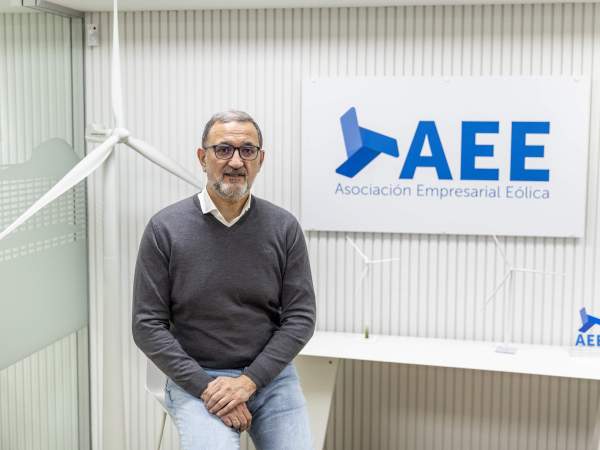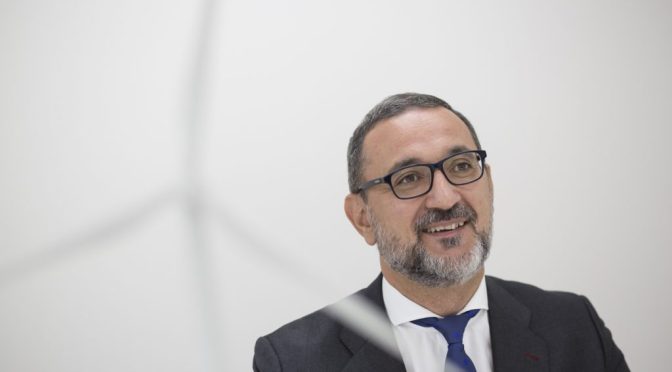The climate emergency and the war in Ukraine (due to the desire not to depend on Russian gas) have accelerated the economic opportunities of renewable energies. And Spain, with sun, wind and a powerful industry, especially wind energy, takes advantage of its advances. But beyond the photos of political leaders with helmets and turbines, not all the wind blows in favor. Juan Virgilio Márquez (Madrid, 1973), general director of the Spanish Wind Energy Association, knows this well and points out, in addition to the strengths, the difficulties that the sector faces.
The difficult profitability of park construction companies due to high costs (which have cost hundreds of jobs in Spain in recent years), heavily subsidized Chinese competition and the territorial imbalance, with dismal Catalan performance, are some of them. But, in addition, explains this telecommunications engineer from Madrid with 25 years of experience in the sector, an excess of renewables is of little use if electricity demand does not increase and this can only happen by decarbonizing sectors where gas and fossil fuels resist, such as mobility or domestic air conditioning.
The European Commission announced this week an investigation against Chinese wind turbine manufacturers for landing in Spain with subsidies from their country. Is it something that worries the sector?
Yes, we have been calling for this type of research and intervention for a long time. A perfect storm occurred because the recovery from covid in unison of all countries brought with it an increase in prices and also delivery times. Compliance with contracts became complicated and the manufacturer had to absorb losses due to extra costs associated with raw materials. At that time, the Chinese industry wanted to open markets and Europe offered fewer barriers than Brazil or the United States, which have more protected local industrial content. The European market was the one in the greatest hurry to incorporate wind power into its market, which was mixed with the financial vulnerability of industrial companies.
And what do they offer so that you cannot compete?
Well, basically, offers and discounts of up to 40% with payment grace periods of up to two years. In other words, I order a machine and I don’t pay for it until two years from now. Against that, the European industry cannot compete and they succeed because they have financial support from the state that does not exist in any other country. They manufacture there and expand here.
Would this improve if Europe approves something similar to the IRA (Inflation Reduction Act), which encourages companies to have headquarters and factories in their country?
Yes, there are two strategies: one is the tax incentive for bringing factories to the country, which makes it more competitive and more profitable. Europe does not usually work in this area. And another is the industrial cohesion of the value chain, which there are countries that promote and countries that do not. Europe is dead if it wants to compete in wind energy as if it were a commodity, without focusing on the value chain. This focus on prices is one of the reasons why there have been so many layoffs and losses in the sector in recent years. But the Chinese industry has a strategy that is to open in a country, deploy there with institutional aid and after winning the market, relocate the factories to another third country, which is what happened with photovoltaics.
Does this apply to other industrial sectors, such as automotive or electric batteries?
Yes, it is a common philosophy of these Chinese industrial companies. Whoever thinks that opening a Chinese factory in Europe means developing local employment is wrong: it is bread for today and hunger for tomorrow. European brands have to lead the market and not lose the leadership train.
And can this happen? There are many European policies to encourage green industrialization, but it is always pointed out that the United States is doing much better.
In Europe there is a lack of cohesion, everything is much more complicated because there are states that are separate. In June of this year, the European Industrial Zero Act will be approved, but to get an idea of the differences: the American IRA had 50,000 pages when it was approved, while the Industrial ACT has 36. What the industry needs is that level of detail from the United States and Europe, if it arrives, it will arrive late. In December, a European letter on wind energy comes out, which Spain is the first country to sign, with the commitment of 36 states and 300 companies to promote this industry. But it is not binding. We must guarantee that price is not the only important thing when producing wind power and that there are prequalification mechanisms, so that not everyone can operate with wind power.
Why is Catalonia so stagnant in renewable energies?
The differences between territories always have to do with the collaboration of the administrations and the acceptance of the territory. What has made the difference between the average 10 years of development of a project in Catalonia and the 3 in Aragon are regional policies and the opposition of municipalities. Catalonia is one of the places where there has been the most opposition from the territory to parks.
And doesn’t the sector criticize itself for not having managed to get the territory to make these projects its own?
Yes, of course, there are promoters who know how to work and others who comply with the law and that’s it. We must advance in practices that go further and make the territories feel part of the renewables. But it is also true that we are in a climate emergency and that renewables cannot wait.
Should Catalonia be worried about its delay?
Yes, of course, the wind farms are not built in Catalonia, they will be built somewhere else. There are 22,000 MW of wind power with a positive Environmental Impact Statement in Spain, only 370 in Catalonia and 30,000 MW installed, 1,300 of them in Catalonia. This places Spain on the path towards the PNIEC plans of having 50,000 MW in 2030. Territorial imbalances will lead to energy being evacuated from Aragon to Catalonia and that generates other problems. Catalonia needs to generate renewable energy of proximity and size, just as it has a nuclear power plant. Concentrating renewables in some communities and not having them in others requires high voltage lines that generate other problems.

So you are against the Very High Voltage line from Aragon to Catalonia?
We do not express ourselves about specific sectors. If Catalonia had an attraction for renewables like Aragón, this would not happen. The opportunities are where they are, although the ideal would be proximity generation and consumption. The Mat also generates opposition in the environment and does not generate the employment that a wind farm generates.
The auction for offshore wind is suffering many delays. Does this put investments at risk?
We prefer to look positively at the opportunity we have. Floating wind power is not yet competitive like the rest and, due to the high sea depths around Spain, we must use floating wind power and not anchored to the seabed. This must be the year in which the first auction is called, yes, and even so it will be very difficult for us to reach the 2030 forecasts. Spain has a naval industry and a very powerful wind sector with commitments to manufacture in Europe and other countries . And if we do not take advantage of the industry we have in floating wind this year, other countries will take advantage of it.
You have told me before that they do not comment on specific cases, but the Gamesa crisis is very relevant for the sector. How do you see the possible rescue of the Spanish Government?
We cannot position ourselves, we only hope that the industries as a whole are financially healthy as soon as possible to return to the market the same as before the crisis.
How healthy is the Spanish wind sector?
We have the entire value chain in Spain and that is a strength but it is difficult to articulate it. We have had consecutive quarters of losses for all European manufacturers but they have endured because they have great financial capacity and a huge portfolio. We are walking towards a great future and we have many opportunities. Spain is the sixth country in the world in wind patents and the 3rd in the European Union. But we have to improve the pace of processing: the battle is administrative capacity, which is agile and linear.


